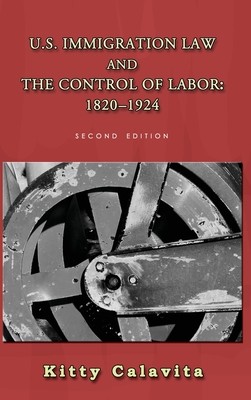
- We will send in 10–14 business days.
- Author: Kitty Calavita
- Publisher: Quid Pro, LLC
- ISBN-10: 1610274172
- ISBN-13: 9781610274173
- Format: 15.2 x 22.9 x 1.8 cm, kieti viršeliai
- Language: English
- SAVE -10% with code: EXTRA
Reviews
Description
Reagan's 1986 immigration reform law offered a composite of contradictory measures: sanctions curtailed employment of undocumented workers while other programs enhanced labor supply. Immigration law today continues the theme of contradictions and unmet goals. But hasn't it always been so? Examining a century of U.S. immigration laws, from the nation's early stages of industrialization to enactment of the quota system, Calavita explores the hypocrisy, subtext, and racism permeating an unrelenting influx of European labor.
Now in its second edition, this groundbreaking book offers a materialist theory of the state to explain the zigzagging policies that alternately encouraged and ostensibly were meant to control the influx. The author adds a 2020 Preface to place the historical record into modern relief.
Writing in a new Foreword as well, Susan Bibler Coutin is "struck by the relevance of Calavita's analysis to current debates over immigration policy," as this social history "reveals alternatives to the present moment: over much of U.S. history, government officials actively recruited immigrants, even when segments of the public sought restrictions." The aim was not "social justice or human rights, but rather to fuel economic expansion, depress wages, and counter unionization." The book is recommended to a wide audience: "The theoretical discussion is accessible to new students as well as established scholars, and the rich documentary record sheds light on how current dynamics were set in motion."
"Calavita lucidly and brilliantly clarifies the linkages among economic structure, ideology, and law making. She effectively depicts the history of U.S. immigration legislation as a series of attempted resolutions to recurring dilemmas rooted in the fiscal and legitimation crises facing the state."
-- Marjorie Zatz, Vice Provost, UC-Merced, in International Migration Review (1986)
EXTRA 10 % discount with code: EXTRA
The promotion ends in 23d.07:48:20
The discount code is valid when purchasing from 10 €. Discounts do not stack.
- Author: Kitty Calavita
- Publisher: Quid Pro, LLC
- ISBN-10: 1610274172
- ISBN-13: 9781610274173
- Format: 15.2 x 22.9 x 1.8 cm, kieti viršeliai
- Language: English English
Reagan's 1986 immigration reform law offered a composite of contradictory measures: sanctions curtailed employment of undocumented workers while other programs enhanced labor supply. Immigration law today continues the theme of contradictions and unmet goals. But hasn't it always been so? Examining a century of U.S. immigration laws, from the nation's early stages of industrialization to enactment of the quota system, Calavita explores the hypocrisy, subtext, and racism permeating an unrelenting influx of European labor.
Now in its second edition, this groundbreaking book offers a materialist theory of the state to explain the zigzagging policies that alternately encouraged and ostensibly were meant to control the influx. The author adds a 2020 Preface to place the historical record into modern relief.
Writing in a new Foreword as well, Susan Bibler Coutin is "struck by the relevance of Calavita's analysis to current debates over immigration policy," as this social history "reveals alternatives to the present moment: over much of U.S. history, government officials actively recruited immigrants, even when segments of the public sought restrictions." The aim was not "social justice or human rights, but rather to fuel economic expansion, depress wages, and counter unionization." The book is recommended to a wide audience: "The theoretical discussion is accessible to new students as well as established scholars, and the rich documentary record sheds light on how current dynamics were set in motion."
"Calavita lucidly and brilliantly clarifies the linkages among economic structure, ideology, and law making. She effectively depicts the history of U.S. immigration legislation as a series of attempted resolutions to recurring dilemmas rooted in the fiscal and legitimation crises facing the state."
-- Marjorie Zatz, Vice Provost, UC-Merced, in International Migration Review (1986)


Reviews